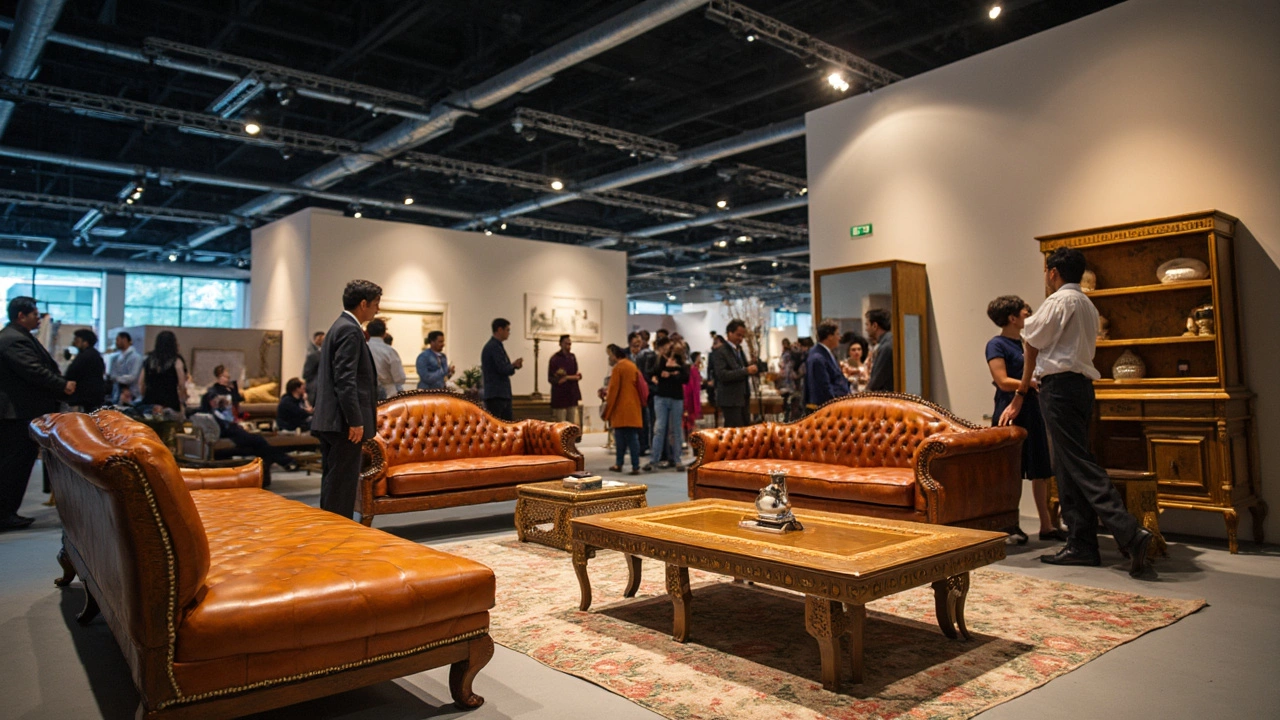Everyone's got that friend who swears by Italian leather sofas or those Instagram feeds filled with Danish minimalism. But when it comes to picking a country for the best furniture, it’s not just about good looks. It's about materials, skill, price, and how long that piece actually lasts you.
Most people forget to look beyond the hype. Indian furniture, for one, often gets overlooked because the market's crowded with flashier foreign brands. Yet, India has a wild range of styles, from hand-carved teak work in Rajasthan to sleek, modern designs coming out of Delhi and Bengaluru. Here’s the kicker: a lot of the solid-wood furniture you find in pricier stores abroad was actually made in India, then branded elsewhere and marked up.
Before deciding what counts as the "best," think about what you need—a functional work-from-home desk, a dining set that can handle big family dinners, or something that just looks cool on Zoom calls. Each country has its own strengths, and ignoring that is like buying shoes just for the brand, not comfort.
- The Global Furniture Makers: Who’s in the Race?
- Why Indian Furniture Stands Out
- Comparing India with Italy and China
- How to Spot Quality: Buyer’s Tips
The Global Furniture Makers: Who’s in the Race?
The furniture game is crowded. If you walk into any big home store, the tags are like a world tour—India, Italy, China, Vietnam, and a few spots in Europe that are proud of their traditions. Let’s actually pull up the big players and see how they stack up when it comes to volume, reputation, and what you actually get for your money.
- Furniture manufacturers India have a reputation for solid wood, hand-carving, and old-school joinery. India also pumps out modern pieces at massive scale for export, which turn up in shops across Europe, the US, and the Middle East.
- China is the king of volume. They’re the world’s largest furniture exporter, with factories pumping out flat-pack pieces and modern sets for IKEA, Walmart, and a bunch of popular budget brands.
- Italy is the go-to for folks who want statement pieces. Italian brands lean heavy on design and luxury finishes—think leather, marble, and those Instagrammable curves.
- Vietnam is huge for outdoor and budget-friendly furniture, thanks to their scale and affordable labor. You’ll find hidden gems from there in big-box stores everywhere.
- Germany and Poland are big on engineered wood and minimalist design, with solid build quality but usually at a higher price point.
Here’s real data to frame it. In 2023, China led the global furniture export pack by a mile, followed by Germany, Italy, Poland, and Vietnam. India might not top the export charts, but their stuff is used by luxury and mass-market brands globally. Check this out:
| Country | Exports (USD Billion) | Main Strengths |
|---|---|---|
| China | ~$70 | Volume, mass production, low prices |
| Germany | ~$12 | Engineering, flat-pack, durability |
| Italy | ~$11 | Luxury design, craftsmanship |
| Poland | ~$12 | Affordable and reliable, especially for Europe |
| Vietnam | ~$10 | Outdoor furniture, low cost, scale |
| India | ~$2 | Handcrafted wood, bespoke pieces, carving |
So, what’s the takeaway? If you’re after affordable, off-the-shelf stuff, China and Vietnam have you covered. Looking for something unique or artisanal? India and Italy bring the goods. And if you want engineered function, Germany and Poland are solid bets. But the smartest shoppers know to dig into the type of furniture and finish they want, because every country has a niche where they totally shine.
Why Indian Furniture Stands Out
When you think of furniture that’s solid, stylish, and built to last, India deserves a spot at the top. The rapid growth of furniture manufacturers India has changed the game for both Indian buyers and people overseas. Here’s why Indian furniture isn’t just another alternative—it’s often the main event.
The first thing to know: Indian furniture usually means real wood. We’re talking about hardwoods like teak, sheesham (Indian rosewood), and mango. You won’t get particle board here unless you’re specifically asking for it. That’s a big deal because solid-wood pieces last longer, take more weight, and stay looking good even after years of use.
Craftsmanship is another deal-breaker. India has entire towns where generations have been working on the same craft—think Saharanpur for wood carving, Jodhpur for rugged, functional pieces, and Kerala for traditional rosewood. Workers here don’t just slap pieces together; they use hand tools passed down in families, finishing every detail by hand.
Handmade doesn’t mean slow. Indian manufacturers have gone global—not just in design but also in logistics. Almost $2 billion worth of furniture is exported annually from India, according to a 2024 trade report. Major international retail giants like IKEA and Pottery Barn source their wooden furniture from Indian factories.
| Wood Type | Key Region | Quality Perk |
|---|---|---|
| Teak | Kerala, Karnataka | Very durable, water-resistant |
| Sheesham | Rajasthan, Uttar Pradesh | Rich grains, hard-wearing |
| Mango | Madhya Pradesh, Maharashtra | Eco-friendly, affordable |
Styles keep up, too. Indian furniture isn’t stuck in the past. While you’ll find plenty of vintage-inspired pieces, cities like Bengaluru and Mumbai are full of makers turning out ultra-modern modular sets that fit right into urban apartments or minimal offices.
If you care about the planet, this is good news: Most big Indian brands are leaning into sustainability. Mango wood, for example, is repurposed from fruit orchards after the trees stop bearing. Some leading firms let you trace the FSC-certified (responsibly sourced) wood in your furniture, giving you peace of mind.
The best part for buyers? Value. The same mahogany table that costs a fortune in Paris or New York often comes from India’s factories—just rebranded and marked up. If you buy from a top Indian brand, you’re often cutting out extra costs and getting the same, or sometimes even better, build quality.

Comparing India with Italy and China
So, how does India actually stack up against the big two in the furniture world—Italy and China? Let’s keep it real: each country has its own thing going, and knowing what you’re buying helps you get the best deal and quality.
Italy is often the gold standard for designer furniture. Think about those jaw-dropping luxury sofas and sleek chairs—brands like Natuzzi and Poltrona Frau have set trends for decades. Italian furniture is all about craftsmanship and high-end materials. But there’s a catch: you’re often paying for exclusivity and the brand, which means a simple coffee table can cost as much as your month’s rent.
China, on the other hand, is the king of affordability and scale. Walk into any furniture megastore worldwide—odds are, a chunk of what you see was made in a Chinese factory. Chinese furniture manufacturers focus on mass production with crazy speed, which keeps prices low. There’s a trade-off, though: corners can get cut on solid woods or finishes, so longevity isn’t always a big selling point unless you know which brands to trust.
Now, where does Indian furniture come in? Here’s where things get interesting. India is like a sweet spot between the two. Local makers use solid wood—especially teak, sheesham, and mango wood—which is a big deal if you want something sturdy and long-lasting. While you might not get the flashy designer labels of Italy, you get serious craftsmanship. Family workshops in places like Jodhpur and Jaipur have been doing handwork for generations. The designs? They can go from old-school carved cupboards to minimalist modern tables.
If finding sustainable pieces matters to you, India’s got an edge. Many Indian workshops use reclaimed or responsibly sourced wood because it’s cheaper and easier than importing. So, the "best furniture manufacturers India" have actually moved ahead in eco-friendliness without charging a premium for it.
- If you want affordable and quick, China’s hard to beat, but watch for quality.
- If you crave prestige and cutting-edge design, Italy’s your pick, with a big price tag.
- But if you want solid wood, skilled handwork, a decent price, and a global-modern vibe, furniture manufacturers India are your friend.
Bottom line? Decide what features matter most—materials, design, price, or brand. India’s blend of value and craft is tough to ignore, especially if you look beyond just the labels.
How to Spot Quality: Buyer’s Tips
Don’t just trust the price tag. Whether you’re looking at Indian, Italian, or Chinese-made pieces, you have to check for quality yourself. Some international brands are just slapping on labels, but the real story is in the details.
- furniture manufacturers India often use solid wood like Sheesham, teak, or mango. Knock on the piece – if it sounds hollow, it’s probably plywood or MDF inside. Solid wood feels heavier and never makes that ‘echo’ sound.
- Check the joints. The strongest ones use mortise-and-tenon or dovetail techniques. If you spot a bunch of screws and glue, move on.
- Open every drawer and door. Smooth sliding means quality work. Stickiness, rattling, or uneven gaps? Red flags right there.
- Feel the hardware. Cheap pieces have flimsy handles that wiggle. A good manufacturer uses sturdy brass or steel.
If you want numbers, here’s something interesting. According to India’s Export Import Bank, nearly 85% of premium wooden furniture exports from India use processed hardwoods, while about 70% from China rely on particleboard. There’s a reason these Indian tables and beds last longer, especially in hot or humid places.
| Check | India | Italy | China |
|---|---|---|---|
| Common Materials | Teak, Sheesham (solid wood) | Beech, cherry, oak (solid & engineered wood) | Particleboard, engineered wood |
| Joinery | Hand-cut dovetail, mortise-tenon | CNC-milled joints | Mainly staples, glue |
| Finishing | Hand-polished, natural waxes | Varnish, lacquer | Lacquer, plastic coating |
| Average Lifespan* | 15+ years | 20+ years | 5-10 years |
*Based on regular household use
One more tip—if you’re buying Indian furniture offline, smell it. Real wood (especially teak) has a musky scent. Fake stuff smells like glue, paint, or nothing at all.
And finally, always ask about the warranty. Quality pieces should have at least a 2-year warranty, minimum, no matter where it’s made. If they won’t give that, there’s probably something they’re hiding.
